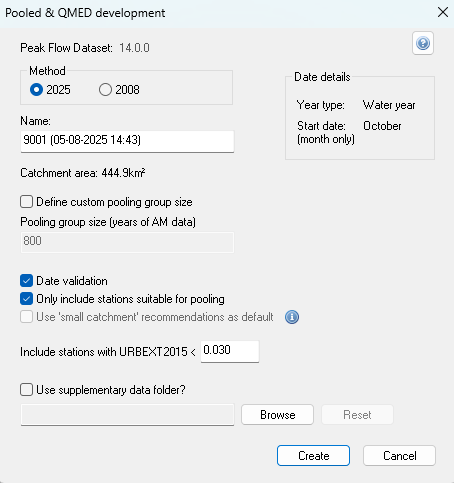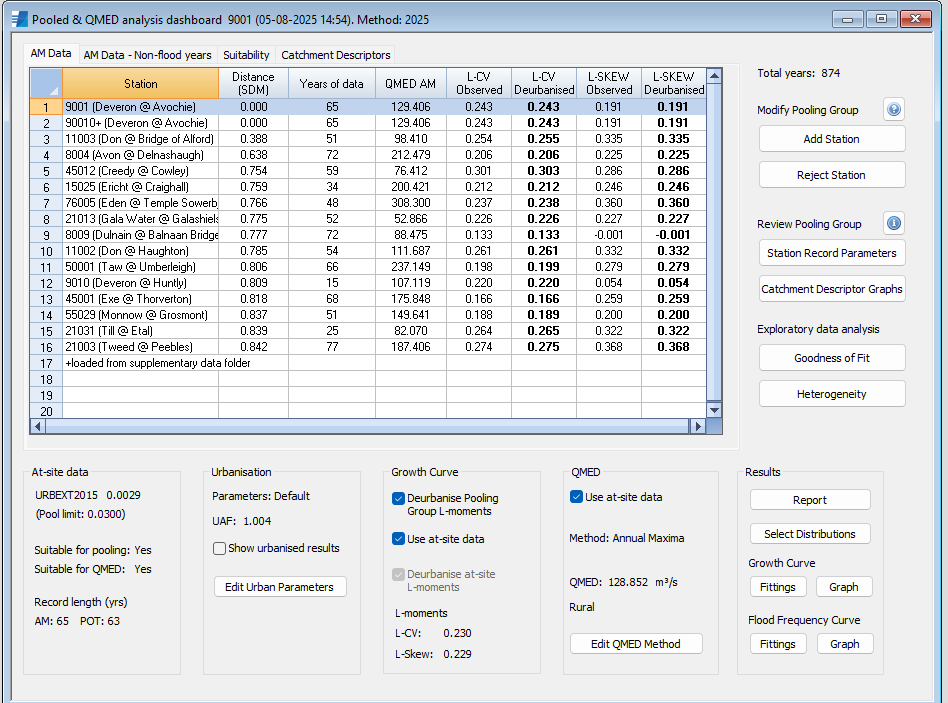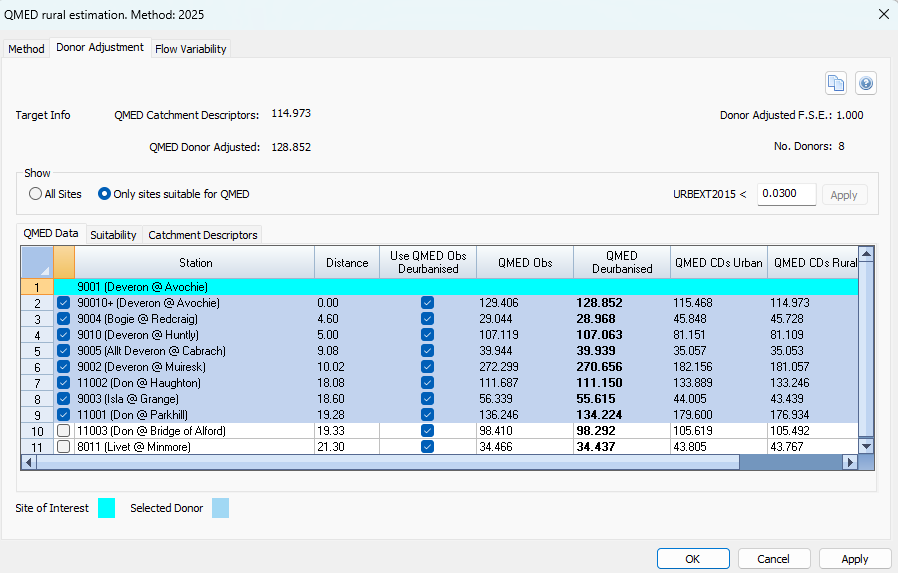Project Files, File Management and Reporting
The Project File
The Project File (.wxml) provides a record of the settings and results for a 'Pooled & QMED Analysis' and therefore saves all the relevant settings and data for this method. Each Project File contains a single Site of Interest. You can save flow estimates in the Project File as part of a project audit trail and share these with colleagues or other users.
You can create project files by using File>Save or File>Save as..... Previous projects can be opened using File>Open Project.
The Project File references the NRFA Peak Flow Dataset, e.g. version 10.0, that was used when it was created. If that version is not currently referenced in the software you will be asked to download it from the NRFA website and register it. It is not possible to open the project file unless the referenced dataset is downloaded. Version 10 and onwards of the NRFA Peak Flow Dataset are available to download from the NRFA website.
If you open a Project File but do not have access to the original supplementary folder or edited data used, the sites that have been used in the analysis detailed in that project, which are identified as either edited or in the supplementary folder, will be available for subsequent analyses e.g. creating a new pooling group.
Additional sites, which may have been within the original supplementary folder but which were not directly used in the estimation methods, are not available for use unless the relevant supplementary folder is identified through either selecting to initiate a new Pooled & QMED Analysis or opening the Station Manager. On selecting either of these, a warning is presented highlighting that supplementary data was previously used in the project and that the identified folder cannot be found. You will be asked to identify this folder, provide an alternative, or continue without the additional data.
-
If a folder is not identified, the list of stations in the Station Manager contains the NRFA Peak Flow Dataset and any additional stations identified in the Project File which were utilised in either the Pooling Group table or the QMED Donor table.
-
If an alternative folder is identified, additional data that is not already present in the project is loaded from the selected folder and used in any subsequent analysis.
The Supplementary Folder : managing additional and edited sites
If additional or edited sites are required for analysis these can be added via a 'supplementary' folder. This contains any additional or edited sites to be used in a project. The supplementary folder can be unique for each project, for example it may be a folder in your companies shared project folder system that can be utilised by colleagues for that project.
Details relating to any additional or edited sites are included in the Project File. On opening the Project File you are able to view the results of the previous analysis in full, whether or not any of the original edited or created sites are accessible. Note that if you complete further analysis (for example creating a new growth curve pooling group or QMED donor adjustment) without having the original supplementary folder this reanalysis uses the available stations in your Station Manager only. See Project File for more details.
The supplementary folder is specified at the initiation of a Pooled & QMED Analysis. You can select to 'Use supplementary data folder?' and browse to the appropriate folder.

Sites used from the supplementary folder are highlighted with a + in the sidebar for the Pooling Group table, the QMED Donor table, the Station Manager and the Project Report.
This is illustrated below for the pooling group and QMED adjustment donor tables, where a 'new' station has been created and added to the supplementary folder, based upon station 9001 and given a Unique site number of 90010. Note that if the station had been added to the supplementary folder with a site number of 9001 then this would be used in preference to the 9001 site from the NRFA Peak Flow Dataset (see notes on the Unique site number).


You are able to select a different supplementary folder by selecting the 'reset' button. It is only possible to have one set of stations in the Station Manager at any one time hence selecting this will results in all current pooling groups, project pooling group station edits and any previous project supplementary folder station data being removed.
Project Report
A project report can be created from the Pooled and QMED Analysis dashboard via 'Report'. The report can be saved as a pdf, html or xml.
The report is designed to act as an audit control for the flow estimate derived in the Pooled and QMED analysis, with the pdf report including:
- tables and graphs of the final estimate of the QMED, growth curve and Flood Frequency Curve (FFC),
- the date of creation of the report and the software version used,
- sources of data, e.g. the NRFA Peak Flow Dataset used and if there is a supplementary folder,
- pertinent descriptors for the target site,
- where at-site data exists: a time series graph of the AM data, and graphs of the single site FFC and growth curve,
- all settings relating to the FFC, e.g. whether at-site data were used and the urbanisation settings,
- tables detailing the final pooling group including your comments,
- a table of pooling group rejected stations,
- details relating to the QMED estimation method including your comments where appropriate,
- any relevant flags, e.g. relating to whether a site has been edited or is from the supplementary folder,
- any warnings, e.g. if a user has used inconsistent settings relating to urbanisation, and
- an appendix containing additional graphs associated with the Station Record Parameters and Catchment Descriptor Graphs.